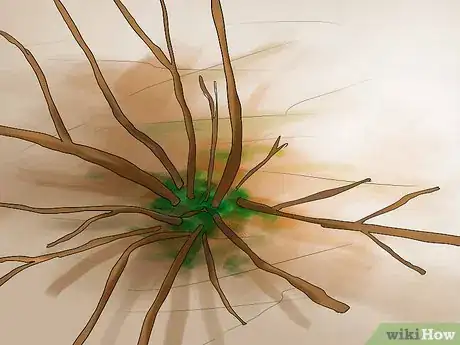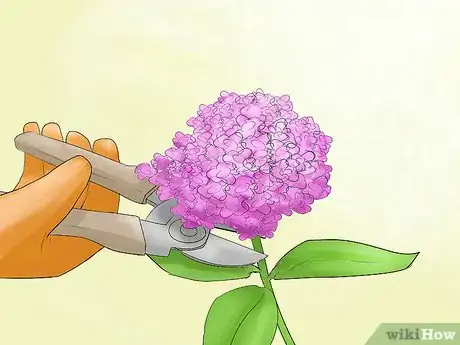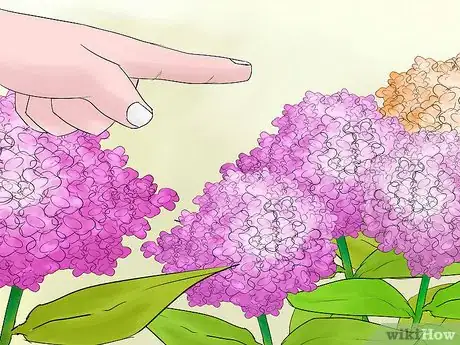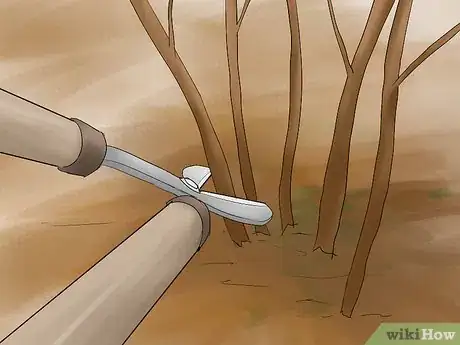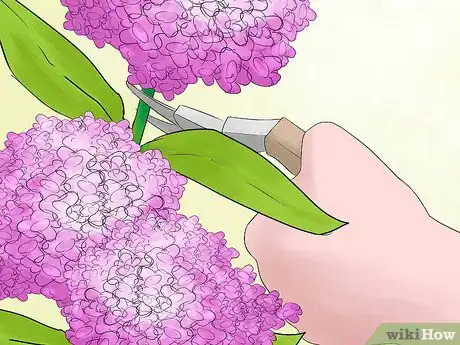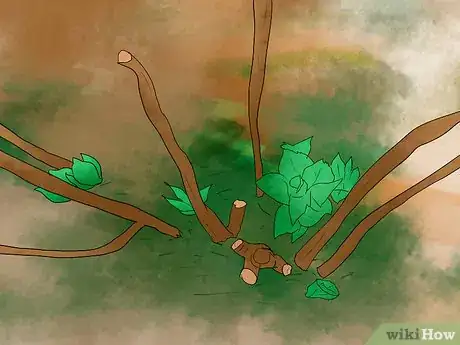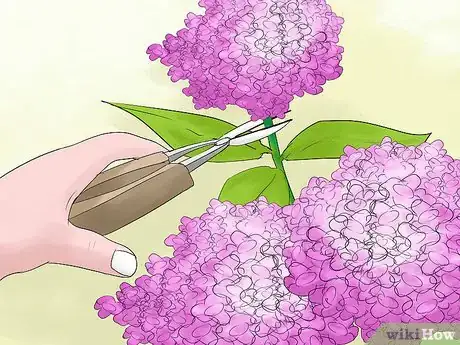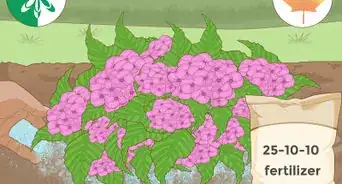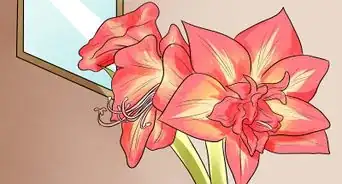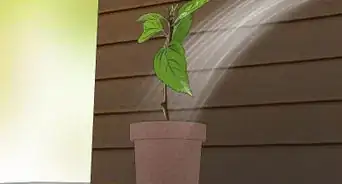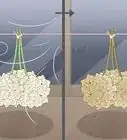This article was co-authored by Maggie Moran. Maggie Moran is a Professional Gardener in Pennsylvania.
wikiHow marks an article as reader-approved once it receives enough positive feedback. This article received 19 testimonials and 92% of readers who voted found it helpful, earning it our reader-approved status.
This article has been viewed 809,412 times.
Pruning hydrangeas can help them retain a pretty shape and produce beautiful blooms year after year. Not all hydrangeas are pruned at the same time, so it's important to know what variety you have before you go outside with those pruning shears. if you prune your hydrangea at the wrong time of year, you could cut into next season's blooms. See Step 1 to learn when and how to prune your hydrangea.
Steps
Pruning Hydrangeas that Bloom on Old Wood
-
1Determine if your hydrangea blooms on old wood. This is another way of saying that your hydrangea produces new spring blooms on last year's buds. Hydrangeas with this characteristic tend to bloom in early summer, and the flowers die by mid summer. At this point the shrub begins producing the buds that will bloom the following year. Hydrangeas that bloom on old wood include the following:
- Bigleaf, Mopleaf or Lacecap hydrangeas (Hydrangea macrophylla and H. serrata)
- Oakleaf hydrangeas (H. quercifolia)
- Use the images at http://www.hydrangeashydrangeas.com/identify.html to help you identify what kind of hydrangea you have before you start making any plans to prune your plant.
-
2Prune just after the blooming peak. Since these types of hydrangeas start producing buds soon after blooming, in late summer and early fall, it's essential to prune them just as the blooms begin to fade in mid-summer. This way you can trim the shrub before it begins to produce the buds that will turn into next year's flowers. The longer you wait, the likelier it will be that you'll cut off some of next year's growth.[1]
- If you've missed this window, just wait until next year to prune the hydrangea. Hydrangeas don't have to be pruned every year, so it won't be a problem to wait.
- If you're unhappy with your hydrangea's shape, you can go ahead and prune - just know that in doing so outside of the short midsummer window, you'll risk hurting it's appearance next spring.
Advertisement -
3Remove old blooms. Right after they're spent, use hand shears to deadhead the blooms. Do this by making clips just under the heads at the tips of the stems. This will tidy up the hydrangea's appearance during the blooming season.
- You can also remove dead or dying canes at this time; trim them at their base.
-
4Remove the oldest canes. When a hydrangea is several years old, it'll start to produce fewer blooms. You can promote fresh growth by taking out some of the older canes - up to 1/3 of them. For thicker canes, you may need loppers to cut them. Cut these older canes to the ground.
-
5Prune the hydrangea to reduce its size. If your hydrangea has grown quite large, you can prune it in June or July (just after the blooming season) to contain it a bit. Trim back the branches by 1/3 to the nearest joint. In most cases hydrangeas will grow back quite quickly, so you may not be able to maintain the smaller size for long.
- This type of pruning isn't necessary for the health of the plant. Only do it if your hydrangea is taking up too much space.[2] When planting new hydrangeas, it's best to choose a spot where they can grow freely.
- "Endless Summer" hydrangeas are an exception to the rule. This variety is more low-maintenance than others and can really be pruned at any season - there is no "bad time."
- Endless Summer hydrangeas can mainly be left alone until they mature. You can then "deadhead" the plant in the spring or fall to encourage new flowers.
Pruning Hydrangeas that Bloom on New Wood
-
1Determine if your hydrangea blooms on new wood. These hydrangea varieties produce new growth each spring, then bloom from that growth later in the summer. They tend to bloom later than hydrangeas that bloom on old wood, since varieties that produce new wood need that extra time to create buds. The following varieties bloom on new wood:
- Panicle hydrangeas (H. paniculata), such as PeeGee or Limelight. These can be pruned into a tree form to make it a focal point of the garden.[3]
- Smooth hydrangeas (H. arborescens), such as Annabelle
- Use the images at http://www.hydrangeashydrangeas.com/identify.html to help you identify what kind of hydrangea you have before you start making any plans to prune your plant.
-
2Prune in late winter before bud generation begins. Since these varieties produce their blooms on new stems, you want to prune them in the winter before they start growing. This is the best time of year to prune new wood varieties, but you can prune them at other times of year as well - just avoid pruning them right before they're about to bloom in the spring and early summer.
- You can cut back all the stems by 1/3 in the winter. Pruning at this time will help the shrub produce bigger, showier flowers.
- However, many gardeners like their hydrangeas to have smaller flowers on sturdier stems. If this is your preference, do your pruning in the fall instead, to allow the plants to grow strong branches before blooming.
-
3Prune dead canes and crossed branches. Use hand shears or loppers to take out dead canes and branches that are crossed or tangled. This will free up the plant and allow for better airflow, encouraging it to grow stronger.
-
4Leave some old growth to support the plant to help it to grow well. Hydrangea flowers tend to be on the heavy side, so don't go overboard pruning old canes. Leave a good network of canes intact so that the branches don't flop over under the weight of the flowers.
Community Q&A
-
QuestionWhy are my hydrangeas not blooming?
 Maggie MoranMaggie Moran is a Professional Gardener in Pennsylvania.
Maggie MoranMaggie Moran is a Professional Gardener in Pennsylvania.
Home & Garden Specialist Sometimes, hydrangeas won't bloom because the old wood is dying back. It can also be caused by pruning at the wrong time and cutting off new growth.
Sometimes, hydrangeas won't bloom because the old wood is dying back. It can also be caused by pruning at the wrong time and cutting off new growth. -
QuestionAre you supposed to deadhead hydrangeas?
 Maggie MoranMaggie Moran is a Professional Gardener in Pennsylvania.
Maggie MoranMaggie Moran is a Professional Gardener in Pennsylvania.
Home & Garden Specialist Yes, you can deadhead hydrangeas. It mainly depends on what time of year it is.
Yes, you can deadhead hydrangeas. It mainly depends on what time of year it is. -
QuestionDo I have to prune my hydrangeas?
 Maggie MoranMaggie Moran is a Professional Gardener in Pennsylvania.
Maggie MoranMaggie Moran is a Professional Gardener in Pennsylvania.
Home & Garden Specialist No, you don't have to prune them, unless you feel the shrub is too large and takes up too much space.
No, you don't have to prune them, unless you feel the shrub is too large and takes up too much space.
References
About This Article
Before pruning your hydrangeas, look online to identify what kind of hydrangea you have so you can determine whether it blooms on old or new wood. For example, species like Lacecap hydrangeas bloom on old wood, while Limelight and Annabelle hydrangeas bloom on new wood. For shrubs that bloom on old wood, prune off the flowers as soon as they start to fade in mid-summer and trim older stems at the base to promote new growth. If you have a shrub that blooms on new wood, cut back the stems by 1/3 in late winter and remove any dead canes. For tips from our Horticultural reviewer on how to prune your hydrangea for a sturdier plant with smaller flowers, read on!
